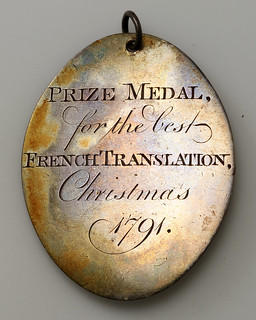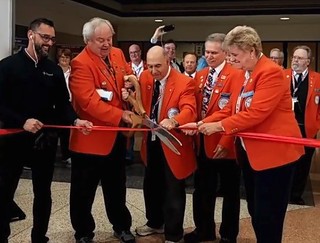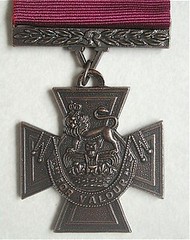
PREV ARTICLE
NEXT ARTICLE
FULL ISSUE
PREV FULL ISSUE
NOTES FROM E-SYLUM READERS: NOVEMBER 10, 2019A Visit to the Philadelphia Mint
Rich Ponder recently visited the Philadelphia Mint and followed the advice of a coin club group that had gone beforehand. -Editor Rich Ponder writes: "Happy to say that I was able to visit the Philadelphia Mint Monday. "Thanks to Drage's advice, I did bring binoculars and used them. The place appeared no more active than when the group was there, but at least I could closely examine the equipment and the few processes in action. • 1-cent blanks being stamped out • Repair or servicing of the conveyor belt that moves the blanks to the later processes • Servicing of minting machines • Polishing of 5-ounce silver coins (this in the medals section). "I got a bargain in the mint store-two squished pennies for the price of one, as a previous customer had not completed turning the crank, and left his or her penny (which was a different design than mine) in the machine. There is something exhilarating about defacing U.S. coins right in front of the Mint security personnel. "After that we went to the nearby Federal Reserve, where they have an exhibit called "Money in Motion" that includes small but interesting displays of early coins and a cross section of banknotes from colonial to recent. Not a big exhibit but definitely worth a stop. Also got my free souvenir bag of shredded U.S. currency." Binoculars are a great idea! I've been on that tour where you're walking along a balcony peering down on the production floor. It's hard to see any detail from that distance. -Editor Translating the Headless Soldier Medal
An experienced translator has likely himself seen his own writing as though through the eyes of General Halftrack, in a "Now what?" episode of Beetle Bailey. If, as is often true even today, the translation is for the benefit of a criminal court, the question "Is that really what happened?" could have sparked many a purchased round at the tavern after work. The languages are abundant sources of hilarity, sometimes whether the occasion is sobering or not. It is an extremely humbling experience as well. I've told it as like unto being a grown man at a third graders desk and every child in the room knows who the dunce is again. I could easily see the point being not at all about who is parodied, but of translation not the best, which is well known. A contemporary classic of the same kind of humor as asking "Who ordered the TV antenna" at a Chinese restaurant. Jeff Rock writes: If it is an award medal it is likely British in manufacture - there likely wasn't that much French being taught in schools in the early United States (though the closer to French Canada one got that would change). If it is British then it is something at least associated with the upper classes - a hand engraved medal in silver would not be something awarded to just anyone and, of course, being that fluent in French suggests a good education which, at this time, was still the preserve of the upper class. There is one great source of information that may turn something up. It's a long shot, with emphasis on the long - as it likely requires 1500 pages of reading! But I would suggest that if the owner has the time and inclination that he take a look through The Gentleman's Magazine, published in London, for the years 1790-1791 (I think all the early volumes have been scanned and are available for free online). But if we assume it was school or club-related there may be some notice of it in this magazine - and there may also be an account of something "in the news" at the time that could explain the significance of the obverse design. While searching a PDF might turn up something, I suspect that the older fonts and sometimes archaic spelling would make OCR unlikely and it would just have to be done by reading each page, which would definitely take some time - but whoever does that may well become the leading expert on British affairs for those years! Thanks - a good idea. -Editor To read the earlier E-Sylum article, see:
The Future of Coin Conventions
Thanks for all you do to make the numismatic world so interesting. You're welcome. The E-Sylum is fun to put together each week. Always something new and interesting. -Editor To read the earlier E-Sylum article, see:
Queen Victoria and the Victoria Cross
Dick Johnson said Queen Victoria's head was on the Victoria Cross - the closest she got was the V which suspends the medal from its ribbon. She DID create the medal which bears her name, and she did award the first medals, but her head is not there. Correct - sorry I missed that. See the article elsewhere in this issue about the Canadian War Museum's Victoria Crosses. -Editor To read the earlier E-Sylum article, see:
Correction: Byzantine Era Not BC
"A Byzantine gold treasure from the 5th century Byzantine Era,..." should be AD or preferably CE (Common Era) Good catch. I missed that. Thanks-Editor To read the earlier E-Sylum article, see:
 Wayne Homren, Editor The Numismatic Bibliomania Society is a non-profit organization promoting numismatic literature. See our web site at coinbooks.org. To submit items for publication in The E-Sylum, write to the Editor at this address: whomren@gmail.com To subscribe go to: https://my.binhost.com/lists/listinfo/esylum All Rights Reserved. NBS Home Page Contact the NBS webmaster 
|


